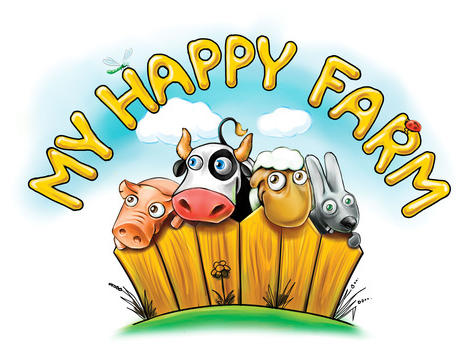
The Basics:
- For ages 6 and up (publisher suggests 8+)
- For 2 to 4 players
- Approximately 30 minutes to complete
Geek Skills:
- Counting & Math
- Logical & Critical Decision Making
- Pattern/Color Matching
- Risk vs. Reward
- Hand/Resource Management
Learning Curve:
- Child – Easy
- Adult – Easy
Theme & Narrative:
- Plant the right crops to feed your clinically depressed animals.
Endorsements:
- Gamer Geek mixed!
- Parent Geek approved!
- Child Geek approved!
Overview
A number of farms are self-sustaining enterprises. Farming families will plant food to feed themselves and their livestock. Their livestock, in turn, will provide eggs, milk, and meat. New seeds will be planted and new livestock will be born. The success of a farm is based on the farming family’s hard work and sacrifice. In this way, a farm is run like a company with every person and animal playing an essential role. Let’s see how good a farmer you are!
My Happy Farm, designed by Oleksandr Nevskiy, Oleg Sidorenko, and published by 5th Street Games, is comprised of 4 Farm mats, 59 Seed cards (9 “Beet”, 21 “Hay”, 11 “Carrot”, 18 “Clover”), 32 Animal cards (“Head” and “Tail” of animals, double-sided), 24 Feeding cards (the “Body” of the animals), and 30 Coins (20 “1 value” and 10 “5 value”). The cards are made of thick cardstock and the mats and coins are made of thick cardboard. The illustrations are bright and the animals are cartoonish.
Game Set Up
Note: The following is for a 4-player game. See “Game Variants” below for specific changes to the game set up when there are only 2 or 3 players available.
To set up the game, first have each player take 1 Farm mat and place it in front of them. Any Farm mats not used are returned to the game box.
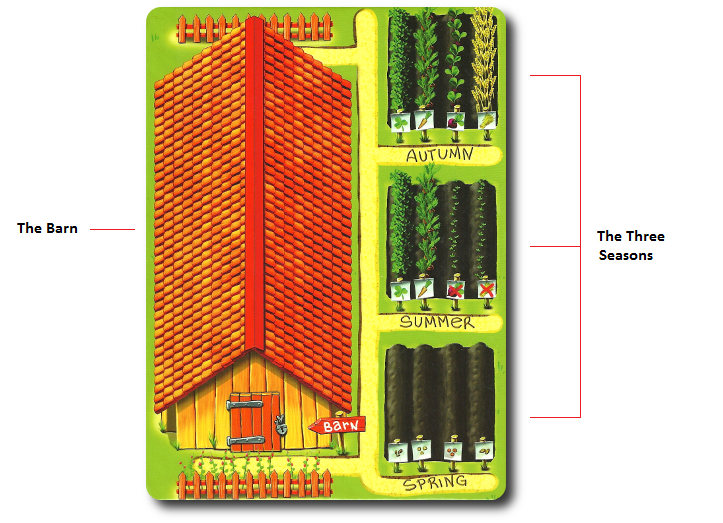
Second, have each player take a full set of Animal cards. A full set of Animal cards is comprised of 1 “Head” and 1 “Tail” Animal card for each of the 4 different animal types (sheep, pig, bunny, and cow). The Animal card sets are placed in front of the player and next to their Farm mat so that each Animal card set forms a full animal. Make sure to place the Animal “Head” card so the “-5” value is face-up (the animal will appear sad) and the Animal “Tail” card does not show a ribbon attached to the animal’s rump. Any Animal set cards not used are returned to the game box.
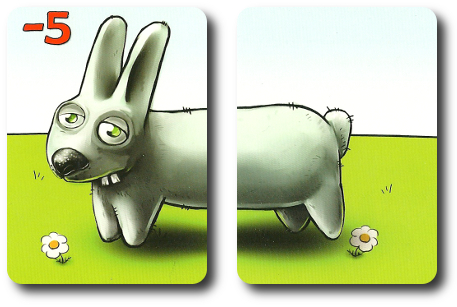
Example of a complete sad “bunny” Animal card set
Third, have each player take 2 “1 value” Coins. The remaining Coins should be placed in a pile and within close enough distance to all players so they can easily reach it. Or assign one player to be the “Banker” and take all the Coins to manage.
Fourth, shuffle the deck of Seed cards and deal 2 Seed cards to each player, face-down. Players should look at their Seed cards, but keep them hidden from their opponents at all times. The remaining Seed cards are placed face-down in the center of the playing area. This is the Seed card draw deck. Now draw the first six Seed cards from the top of the Seed draw deck and place them face-up in a row next to the deck. Leave room for a discard pile.
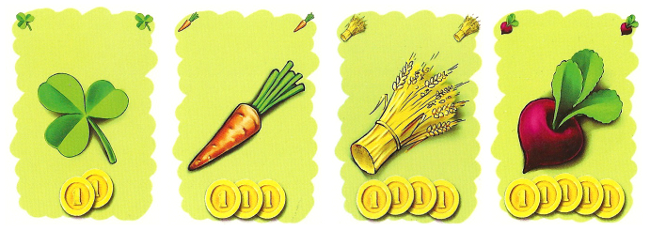
Fifth, shuffle Feeding cards and place the deck, face-down, in the center of the playing area. This is the Feed draw deck. Now draw the first six Feed cards from the top of the Feed draw deck and place them face-up in a row next to the deck. Leave room for a discard pile.
When completed, your playing area might look like the following.
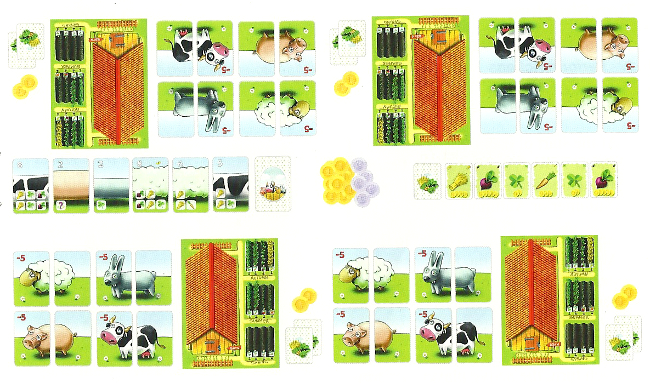
That’s it for game set up. Determine who will go first and begin!
The Country Life
My Happy Farm is played in turns with no specific number of turns per game. Each turn is broken down into turn phases. These phases are summarized here.
Phase 1: Grow Seed Cards
At the start of the player’s turn, all the “planted” Seed cards are moved to the next season space by the player’s Farm mat. The season order goes Spring to Summer, and Summer to Autumn. Any Seed cards on the Autumn space are discarded without being harvested during this phase. Place the discarded Seed cards in the Seed discard pile.
Phase 2: Perform Actions
The player can take 2 of any of the following 6 actions. The selected actions can be taken in any order, but each action can only be performed once per turn.
Buy Seed Cards
The player can buy 1, 2, or 3 visible Seed cards from the center of the playing area. Each Seed card costs a “1 value” Coin (ignore the Coin values on the Seed cards during this action). A purchased Seed card goes to the player’s hand and the top Seed card from the Seed card draw deck is immediately drawn to replace it. The newly placed Seed card can be purchased as soon as it’s placed to the table. If at anytime the 6 face-up Seed cards are all the same Seed type, the entire row is discarded and 6 new Seed cards are drawn.
A player can have no more than 6 Seed cards in their hand.
Plant Seed Cards
The player places 1 or 2 Seed cards from their hand of any Seed type or 3 Seed cards of the same Seed type to the right of the Spring season space found on the player’s Farm mat. Seed cards are planted face-up.
Harvest Seed Cards
The player collects some or all the planted Seed cards located on their Summer or their Autumn season spaces found on their Farm mat. Not both.
- “Carrot” and “Clover” Seed cards can be harvested in Summer or Autumn
- “Beet” and “Hay” Seed cards can only be harvested in Autumn
Harvested Seed cards are then placed in the player’s “Barn” space located on their Farm mat. Note that a player need not harvest all the Seed cards if they do not want to. No more than 6 Seed cards can be stored in the “Barn” at a time. If the player likes, they can discard Seed cards from their “Barn” to bring in new Seed cards. This does not take an additional action.
Sell Seed Cards
The player discards one ore more Seed cards they have in their “Barn” to the Seed discard pile. The number of Coins each Seed card is worth is shown on the Seed card. The player discards the Seed cards they want to sell, takes the Coins from the pile, and adds them to any other Coins they currently have.
Take a Coin
The player takes 1 Coin from the pile and adds it to any other Coins they currently have.
Feed Animals
The player feeds their animals by discarding Seed cards from their “Barn” that match the feed symbols (Carrot, Beet, Hay, or Clover) on the Feed cards currently visible. The Feed card is taken and placed between the matching Animal “Head” and “Tail” cards (you can’t put a “bunny” body between a “cow’ head and tail, for example). Note that there is no limit to the number of Feed cards that can be placed between an animals’ head and tail.
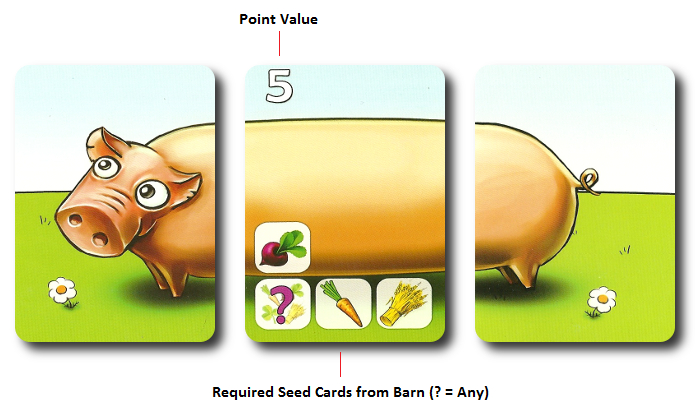
If this is the first time the Animal has been fed, the Animal “Head” card is flipped so that the “-5” is no longer showing. The Animal should now appear to be ridiculously happy.
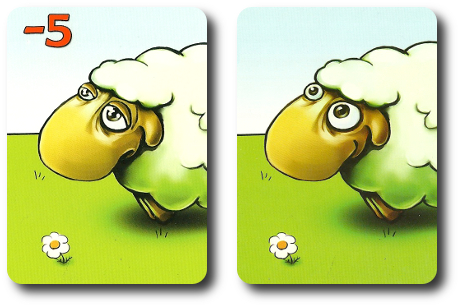
“Depressed” sheep becomes “manic” sheep after being fed
As long as a player has Seed cards to use, they can continue to trade them in for more Feed cards. Whenever a Feed card is taken, it’s immediate replaced by a new Feed card from the Feed card draw deck. Like the Seed cards, any newly placed Feed cards can be taken as soon as they come into play.
The End of a Long Farming Day
The endgame is triggered when a player cannot refill the Feeding cards on their turn.
The player takes their turn as normal and all the other players get one more turn. When the turn order sequence returns to the player who triggered the end game, the final scoring takes place.
Final Scoring
Players now add up their points. Every Feed card played to their Animal has a number value. The players add up all the number values and subtract -5 for every Animal that was not fed.
Players also evaluate the length of all four of their Animal types. Whomever has the longest Animal (determined by counting all the Animal and Feed cards for a specific Animal type) gets an additional +3 bonus points. The player who wins the bonus points takes the Animal “Tail” card for that specific Animal type and flips it over to show a ribbon. If two or more players tie on the same Animal type, no bonus points are awarded.
The player with the most points wins the game and has the happiest farm! If there is a tie, the player with the most fed animals wins.
Game Variants
- If only playing with 2 players, look through the Feed deck and remove from play any Feed cards that have the yellow butterfly or red ladybug on it. Game set up and play is otherwise the same.
- If only playing with 3 players, look through the Feed deck and remove from play any Feed cards that have the yellow butterfly on it. Game set up and play is otherwise the same.
To learn more about My Happy Farm, visit the game’s web page.
Prediction
Farming games continue to be big hits around our family gaming table. Just about everyone in our three groups has enjoyed a Farming game at one time or another. They can range from the very easy to the very complex, but they all share the common theme of cultivating one’s strategy to achieve a bountiful victory.
I predict solid endorsements from the Parent and the Child Geeks. The game is well suited for these two groups. There is nothing in the rules to suggest the game will be overly difficult or it will overstay its welcome at the gaming table. Best of all, the game can be played by the younger Child Geeks. The game publisher suggests 8-years-old and up, but I’m fairly certain my 6-year-old will have no problem learning and playing the game. There is no reading involved and what little math is necessary is simple and can be done for him without harming the game’s play.
For the Gamer Geeks, I don’t think My Happy Farm is going to get their endorsement. Nor do I think the Gamer Geeks are going to say My Happy Farm is a bad game. At the very least, they will acknowledge it as a “children’s game” and scoff at the idea that they should play it at all. I think the Gamer Geeks will find, however, that My Happy Farm is fun and challenging for older and more experienced players, too. Not just the Child Geeks. And while that might very well be the case, it still won’t be enough for the Gamer Geeks to fully endorse it unanimously. If I know my Gamer Geeks (and I do), a number of them are going to love this game and a number of them are going to dislike it.
Teaching My Happy Farm is best done by simply going through each of the actions available to a player on their turn. There are no player reference cards or sheets available to help players remember what actions they can take. Do expect to go through the list of actions and what Seed types can be harvested each season several times during the game. If you have the time, create a player reference card or sheet and pass it around the table. That’s what we did and it worked beautifully.
And so, after teaching the game to my two oldest Child Geeks, I asked them their thoughts on My Happy Farm so far.
“Wow, these animals look crazy sad or just crazy. What’s in their food, Dad?” ~ Liam (age 9)
“So I can make a really long animal? Cool! Let’s play!” ~ Nyhus (age 6)
My little farmers are ready to get to work! Let’s play My Happy Farm and see if it brings joy or it feels force-fed.
Final Word
The Child Geeks either spent their turn laughing at how long their animals were or scratching their head as they attempted to determine what actions would be best. During phase 2 of a player’s turn, I observed all the Child Geeks suffering a bit of analysis paralysis. When I asked one Child Geek why he was having a hard time making a choice, he said, “They’re all good choices.” VERY TRUE! All of the actions a player can take are beneficial. Some are more beneficial than others and timing plays a big part in determining which actions should get focus. The older Child Geeks recognized this immediately with the younger Child Geeks grasping the concept about mid-game. None of the Child Geeks were ever confused. They always new what they wanted to do, but just couldn’t determine sometimes which action should be taken. When the games were over, all the Child Geeks voted to approve My Happy Farm and wanted to name the very long animals they helped raise.
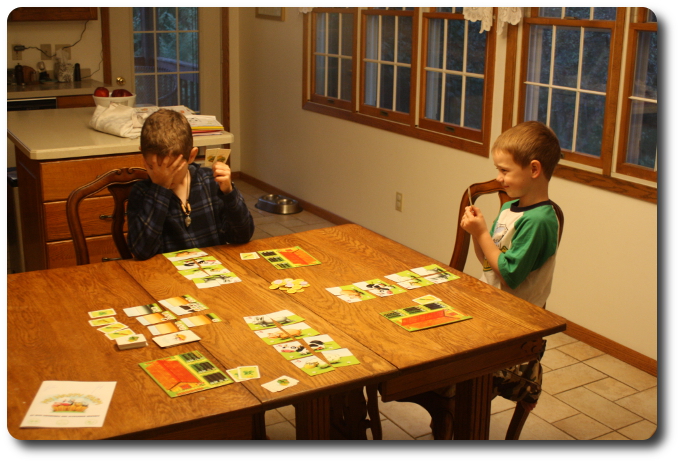
My oldest little geek facepalms himself after his younger brother takes the card he wanted
The Parent Geeks simply adored My Happy Farm and thought it was a very entertaining game for their family and with their peers. The game was found to be very casual and engaging, with little to no downtime between turns. All the games started out slow, but once the Parent Geeks had a round or two under their coveralls, their turns were well thought-out and quickly executed. According to one Parent Geek, “This is a great example of how fun a game can be without being loaded down with a lot of rules.” Another Parent Geek said, “What I like about this game is how easy it was to learn and how much fun it was to play. I didn’t win, but I want to play it again as soon as possible.” All the Parent Geeks voted to approve My Happy Farm.
The Gamer Geeks were mixed when it came to the game. They all agreed it was well designed and would be an excellent gateway game for inexperienced and younger players. However, the game was a bit too simplistic for a number of them. According to one Gamer Geek, “This is a solid game, but the decisions I need to make are always right there in front of me. I didn’t have to think too hard or too deep on my turn. I wanted more out the game.” Most certainly this is a light game, and all the Gamer Geeks acknowledged that, but there were those who said they would happily play it and did endorse it. When I asked one of the Gamer Geeks who voted to approve it , he said, “I’m a gamer, a geek, and this is a game I really enjoyed playing. Enough said.” Enough, indeed.
I’ve heard My Happy Farm described as a “Family game”, a “Gateway game”, and a “Casual game”. It’s all these things. The game play is very straight forward, but challenges players to make important decisions each round. Players must watch their opponents and the cards to determine where they stand in position to obtain victory. Hand and resource management is a must. That sounds like a lot, and it was a bit overwhelming for some of our younger and less experienced players a first, but the game never crushed them or caused stress. If they suffered anything, it was the sting of hindsight.
I rather like My Happy Farm and it’s one of those games I’d never say no to and would even suggest. It’s solid, plays fast, and kept me entertained. The game plays just as well with 2 players as it does with 3 or 4, but it’s the most entertaining with 4 players. Because the game play is casual, everyone at the table can enjoy conversation without losing focus on what they need to do on their turn. Even if a player does lose track, a quick scan of the table and their cards will quickly bring them back up to speed. Do take a look at My Happy Farm when the opportunity presents itself. I have no doubt it’ll bring smiles to all at your family gaming table.
This game was given to Father Geek as a review copy. Father Geek was not paid, bribed, wined, dined, or threatened in vain hopes of influencing this review. Such is the statuesque and legendary integrity of Father Geek.



